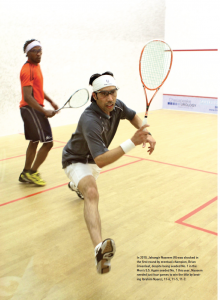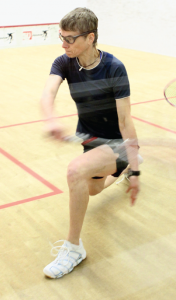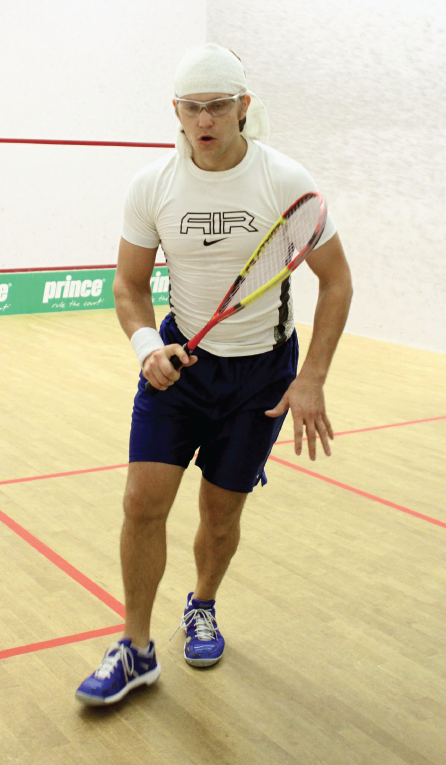By Jay D. Prince
Five quick years after announcing that the U.S. Skill Level Championships would be split from the U.S. Championships, it has become the single-most popular event on the adult singles calendar. No, not because of the size of the culminating event, but rather because when taking into consideration the qualification requirement, over 600 players entered the eight different regional events in hopes of securing a place in the National Championship. And unlike the U.S. Masters, the qualifiers of the Skill Level Championships have been different each year. In 2010, there were no repeat winners. And this year produced just one which in itself speaks volumes about the nature of the Skill Levels.

U.S. SQUASH continues to “tweak” the Skill Level Championships, always with an eye toward enhancing the prestige of the title and to encourage participation. In 2010, winners and runners-up in the Regional Qualifiers were offered free entry into the National event. This year, not only was free entry available, but the Association hoped to only allow the Regional event finalists to gain entry. In other words, the only way to get into the National Championship would be to qualify. A further stipulation was that should any of the Regional finalists opt not to enter the National draw, those finishing in the top-five would be invited (going down the line from 3-5).
In the end, additional players were allowed to play to fill out the draws held in Baltimore (MD) at Meadow Mill Athletic Club on its 14 singles courts. As mentioned earlier, only one player repeated in her division—Beth Fedorowich. In 2010, Fedorowich secured her first national championship by winning the Women’s 4.5. This time around, the 4.0 was the highest draw available to the women, and Fedorowich swept the division without dropping a game. Standing in her way was a local junior in the form of Lindsay Wong (who had beaten her younger sister, Casey, in the semis in five games). But Fedorowich was on fire from the start as she ran away with the opener, 11-2, before closing out the second and third, 11-7 each.
As might be expected, the only other division in which at least one of the finalists this year had been in the finals a year ago was the Men’s 6.0. Expected because there is nowhere else for them to go as it’s the highest Skill Level. In 2010, Joe Russell was seeded No. 2 and survived five-game matches in both the quarters and semis (each required extra points in the fifth). Jacques Swanepoel, seeded No. 1, hadn’t been tested as severely and was expected to beat Russell—especially given the effort he had expended.
But Russell put his years of experience to efficient use and overcame a 2-1 deficit to win the title. Swanepoel wasn’t about to allow that to happen this time around.
Again seeded one and two, Swanepoel reached the 2011 Men’s 6.0 final without dropping a game. Russell, in contrast, needed five to hold Canadian David Sly (a mainstay in the U.S. Masters) back. Sly, seeded No. 3, was seemingly in command after three games but, again, Russell used his deft touch and ball control to reach the final in five games.
Unlike last year, however, Swanepoel wasn’t going to let his two-games-to-one advantage go to waste. After winning the first 12-10 and steam rolling Russell in the second, 11-3, Russell returned the favor by taking the third 11-4. But Swanepoel’s powerful strokes carried him in the fourth as he left Russell with little more than an extended hand of congratulations. With any luck, the two will renew their budding rivalry in 2012 when the event returns to Meadow Mill in March.
Every other division featured a new winner in 2011, including a junior who had won the plate finals of the U.S Junior Closed Boys U19 a month earlier.

David Snyder, exhibiting the youthful stamina and spring in his legs that helps separate the younger from the older players at the Skill Levels, needed five games in each of his early round matches just to reach the final of the Men’s 5.0. In a match between locals, Snyder survived a 2-1 deficit to Douglas Hoffberger in the first round, followed that up with a five-setter over the top seed (Mark Reed) and another in the semis. It wasn’t until the final that Snyder actually found himself leading 2-1 in a match, and he closed it out in four games in a methodical display of court coverage and shot making as he left unseeded Marc Campbell scratching his head for ideas.
The Men’s 3.0 featured a pair of juniors from Baltimore. Seeded No. 1, Andrew Katz needed five games to beat Kyle Bacalzo in the semis, but Brent Criado completed his run through the tournament by stopping Katz in three games. Criado dropped just a single game in his first round match to dominate the division.
The Men’s 4.5 also featured a junior in the final in the form of Max Reed. Just a month earlier, Reed had reached the quarterfinals of the U.S. Junior Closed Boys U15. In Baltimore, Reed lived up to his top-seeding by reaching the final before being stopped in his quest for the title by Petras Baniulis in four games. Baniulis played a part in one of the more unusual occurrences of a squash tournament during the weekend when a support panel outside the back wall shattered after his body slammed into the back wall during his quarterfinal match. It was the second court broken on the weekend, something rarely seen in squash.
Baltimore locals secured two additional titles during the weekend when Jessica Galitzin won the Women’s 3.0 title as the No. 2 seed—she beat top-seeded Barbara Keil in the final, 3-1.
Finally, the 2006 Men’s 5.0 champion added the Men’s 5.5 title to his resume. Jahangir Naseem, seeded No. 1, needed four games to win his quarterfinal (there were eight players in the draw), but just three in the semis before winning the final over another local, Ibrahim Nyanzi, in three games.
Each year, the U.S. Skill Level Championships have become more intriguing. By working in the qualification requirement, each of the players entered arrives with a sense of belonging. Yet the experience of the players is truly representative of the overall membership in U.S. SQUASH. Unlike the Masters Championships, predominantly made up of players rated 4.5 and above in age groups approaching the 70+, the Skill Levels provides equal opportunity at a national title to players ranging from relative beginners all the way through to former and current professionals. As interest grows across the membership in the Association, it is highly likely that we will be talking about over 1,000 players attempting to earn their way into the national spotlight. This year, there were eight Regional qualifiers, but the western U.S. only featured one opportunity to qualify—in Redwood City, CA. Given the number of players in the Pacific Northwest, there is already interest in adding another qualifier in either Portland or Seattle (at least among the players in those cities).
Until then, players can start training now for next year’s return trip to Baltimore in March, 2012.





